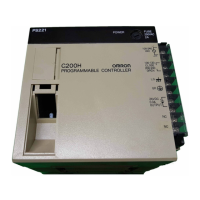109
0000 0001
0002 0003
0004 0005
0501
The first of each pair of conditions is converted to LD with the assigned bit
operand and then ANDed with the other condition. The first two blocks can
be coded first, followed by OR LD, the last block, and another OR LD, or the
three blocks can be coded first followed by two OR LDs. The mnemonic code
for either method is shown below.
Address Instruction Data
0000 LD 0000
0001 AND NOT 0001
0002 LD NOT 0002
0003 AND NOT 0003
0004 OR LD —
0005 LD 0004
0006 AND 0005
0007 OR LD —
0008 OUT 0501
Address Instruction Data
0000 LD 0000
0001 AND NOT 0001
0002 LD NOT 0002
0003 AND NOT 0003
0004 LD 0004
0005 AND 0005
0006 OR LD —
0007 OR LD —
0008 OUT 0501
Again, with last method (on the right), a maximum of eight blocks can be
combined. There is no limit to the number of blocks that can be combined
with the first method.
Both of the coding methods described above can also be used when using
both AND LD and OR LD, as long as the number of blocks being combined
does not exceed eight.
The following diagram contains only two logic blocks as shown. It is not nec-
essary to break block b down further, because it can coded directly using
only AND and OR.
0000 0001 0002 0003
0201
0501
0004
Block
a
Block
b
Combining AND LD and
OR LD
Converting to Mnemonic Code Section 7–2

